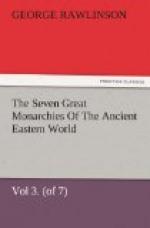There remains, finally, a class of Median names, containing roots not found in any known names of Persians, but easily explicable from Zend, Sanscrit, or other cognate tongues, and therefore not antagonistic to the view that Median and Persian were two closely connected dialects. Such, for instance, are the royal names mentioned by Herodotus, Deioces, Phraortes, Astyages, and Cyaxares; and such also are the following, which come to us from various sources; Amytis, Astibaras, Armamithres or Harmamithres, Mandauces, Parsondas, Eama-tes, Susiscanes, Tithaous, and Zanasanes.
In Deioces, or (as the Latins write it) Dejoces, there can be little doubt that we have the name given as Djohak or Zohak in the Shahnameh and other modern Persian writings, which is itself an abbreviation of the Ajis-dahaka of the Zendavesta. Dahaka means in Zend “biting,” or “the biter,” and is etymo-logically connected with the Greek.
Phraortes, which in old Persian was Fravartish, seems to be a mere variant of the word which appears in the Zendavesta as fravashi, and designates each man’s tutelary genius. The derivation is certainly from fra, and probably from a root akin to the German wahren, French garder, English “ward, watch,” etc. The meaning is “a protector.”
Cyaxares, the Persian form of which was “Uvakhshatara,” seems to be formed from the two elements it or hu, “well, good,” and akhsha (Zend arsnd), “the eye,” which is the final element of the name Cyavarswa in the Zendavesta. Cyavarsna is “dark-eyed;” Uvakhsha (= Zend Huvarsna) would be “beautiful-eyed.” Uvakhshatara appears to be the comparative of this adjective, and would mean “more beautiful-eyed (than others).”
Astyages, which, according to Moses of Chorene, meant “a dragon” or “serpent,” is almost certainly Ajis-dahaka, the full name whereof Dojoces (or Zohak) is the abbreviation. It means “the biting snake,” from aji or azi, “a snake” or “serpent,” and dahaka, “biting.”
Amytis is probably ama, “active, great,” with the ordinary feminine suffix -iti, found in Armaiti, Khnathaiti, and the like. Astibaras is perhaps “great of bone,” from Zend agta (Sans, asthi), “bone,” and bereza, “tall, great.” Harmamithres, if that is the true reading, would be “mountain-lover” (monticolus), from hardam, ace. of hara, “a mountain,” and mithra or mitra, “fond of.” If, however, the name should be read as Armamithres, the probable derivation will be from rama, ace. of raman, “pleasure,” which is also the root of Rama-tea. Armamithres may then be compared with Rheomithres, Siromitras, and Sysimithres, which are respectively “fond of splendor,” “fond of beauty,” and “fond of light.” Mandauces is perhaps “biting spirit—esprit mordant,” from mand, “coeur, esprit,” and dahaka, “biting.” M Parsondas can scarcely be the original form, from the occurrence in it of the nasal before the dental. In the original it must have been Parsodas, which would mean “liberal,




